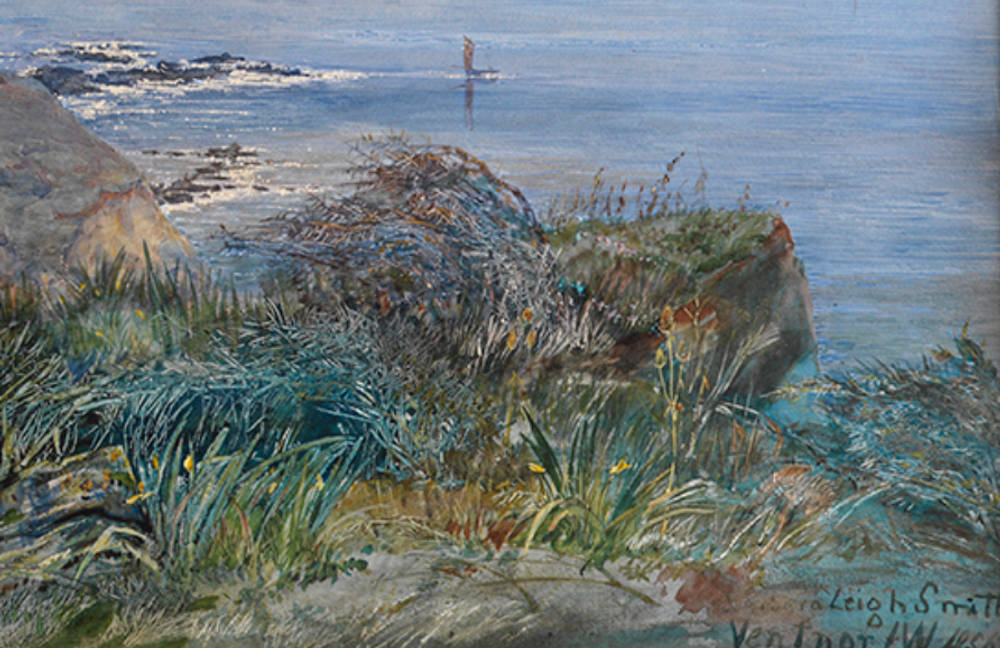
Ventnor, Isle of Wight. Miss Barbara Bodichon, née Leigh Smith (1827-1891). Watercolour and bodycolour with scratching out. 28 x 42.5 inches (73 x 109.2 cm.); signed, inscribed and dated 1856. Provenance: Maas Gallery, London. Exhibited: Royal Academy, 1856, no. 913; Manchester City Art Gallery, November 1997: "Pre-Raphaelite Women Artists." Now in the collection of the Delaware Art Museum, object 2016-25. Image courtesy of Maas Gallery. [Click on the image to enlarge it.]
Commentary by the Maas Gallery
In 1856 the artist, then Barbara Leigh-Smith (she married the next year), stayed with her friend Anna Mary Howitt, also an artist, on the Isle of Wight and painted this picture. Howitt had attended Henry Sass' art academy in 1846 with Holman Hunt and Rossetti, and the Pre-Raphaelites were regular visitors to her house in Highgate. Barbara Leigh-Smith was the illegitimate daughter of the radical Whig politician Ben Leigh Smith and Anne Longden, a milliner from Alfreton. Her first cousin was Florence Nightingale. Well-educated, intelligent and forceful, Leigh-Smith became with Howitt one of "The Ladies of Langham Place" that met regularly in London to discuss women's rights. In 1854, she published her Brief Summary of the Laws of England Concerning Women, which was later used to promote the passage of the Married Women's Property Act 1882. In 1858, she set up the English Women's Journal, concerning employment and equality issues for women. In 1866, with Emily Davies, she came up with a scheme to extend university education to women. The first small experiment in this at Hitchin developed into Girton College, Cambridge, to which Mrs Bodichon gave liberally of her time and money
The picture was well received at the Royal Academy; W. M. Rossetti described it as a "capital coast scene, full of real pre-Raphaelitism."
Robin McInnes has identified the viewpoint to near Luccombe, just to the east of Ventnor, looking northeast across Shanklin Bay to Culver Cliff in the far distance, and suggested that the headland in the middle distance (which has been placed where it should not be) is Woody Point to the west of Ventnor, transposed for artistic effect.
[The Maas Gallery, 6 Duke Street, London SW1Y 6BN has most generously given its permission to use in the Victorian Web information, images, and text from its catalogues, and this generosity has led to the creation of many valuable documents on painting and drawing. The copyright on text and images from their catalogues remains, of course, with the Gallery. Readers should consult their website to obtain information about recent exhibitions and to order their catalogues. — GPL]
Commentary by Dennis T. Lanigan

Closer view of right foreground.
Leigh Smith exhibited this work at the Royal Academy in 1856, no. 913. It is surely one of her masterpieces, painted when she was still under the influence of Pre-Raphaelitism, and at a time when her friendship was closest with members of the Pre-Raphaelite circle. She was particularly friendly with Dante Gabriel Rossetti, who had been introduced to her by her friend Anna Mary Howitt. On November 8, 1853 Rossetti wrote to his sister Christina: "Ah! if you were only like Miss Barbara Smith, a young lady I met at the Howitts', blessed with large rations of tin [money], fat, enthusiasm, & golden hair, who thinks nothing of climbing up a mountain in breeches or wading through a stream in none, in the sacred name of pigment. Last night she invited us all to lunch with her on Sunday, & perhaps I shall go, as she is quite a jolly fellow" (Rossetti, letter 53.57, 294). Bodichon's later work does not reflect these same Pre-Raphaelite influences. The Pre-Raphaelite qualities of Barbara's work of the mid-1850s was discussed by W. M. Rossetti in a letter to the American publication The Crayon of June 20, 1856, in which he commented on a watercolour she had shown that year at the Crystal Palace exhibition: "In the water-colour section I noticed two capital coast-scenes; one by Miss Barbara Smith, full of real Pre-Raphaelitism, that is to say, full of character and naturalism in the detail, as well as multiplicity of it" (245).
This watercolour was painted in January 1856 when Barbara and her close friend Anna Mary Howitt had travelled to Ventnor on the south coast of the Isle of Wight for the specific purpose of painting landscape scenes. The Isle of Wight had proved to be a popular destination for artists because of its picturesque coastal landscape. Barbara may have also chosen this destination because she had family connections there. Ventnor had developed into a seaside resort town in Victorian times because of its favourable climate, particularly during the winter, when it attracted sickly visitors, especially those with pulmonary complaints.
Bibliography
Marsh, Jan, and Pamela Gerrish Nunn. Pre-Raphaelite Women Artists. Manchester: Manchester City Art Galleries, 1997, catalogue no. 3, 103.
Paintings. Salisbury: Wooley and Wallis (23 September 2015): lot 187, 39.
Rossetti, Dante Gabriel. The Correspondence of Dante Gabriel Rossetti. The Formative Years I, 1834-54. Ed. William E. Fredeman. Cambridge, D. S. Brewer, 2002, letter 53.57, 293-94.
Rossetti, William Michael. "Art News from England." The Crayon III (August, 11856): 244-46.
Ventnor, Isle of Wight. Delaware Art Gallery. Web. 1 February 2025.
Created 19 May 2018
Last modified 1 February 2025 (second commentary added)